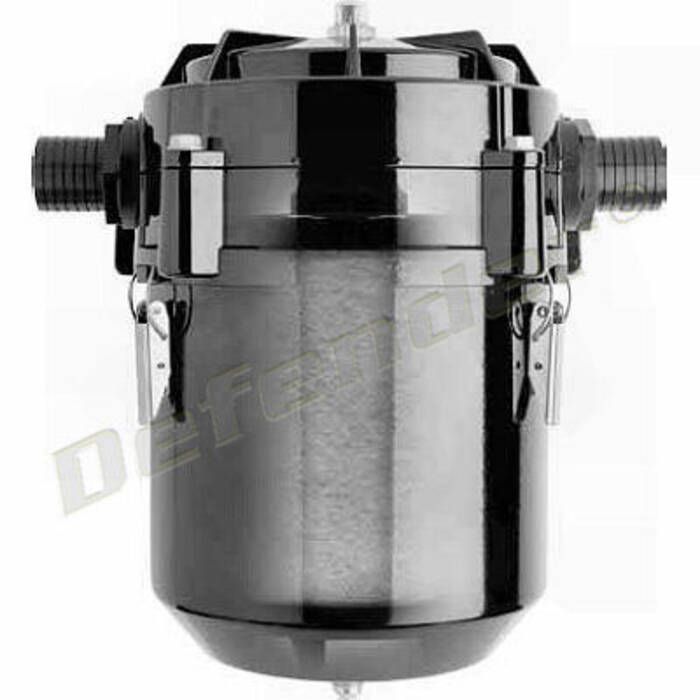Racor Closed Crankcase Ventilation Assembly
Item: #878328 | Part Number: Not Selected

Racor Closed Crankcase Ventilation Assembly Item # 878328

Description
Crankcase blow-by gas is produced when combustion gases under high pressure escape past piston rings into the crankcase. As these blow-by gases pass through the crankcase, they become contaminated with oil mist. In enclosed areas, like generator sets or engine rooms, the contaminated gas coats and damages surrounding equipment, resulting in hazardous conditions and the need for costly maintenance.
Uncontrolled blow-by oil mist also coats engine after-coolers and turbochargers, which reduces cooling capacity and engine efficiency. Racor's Crankcase Ventilation Systems prevent this problem by removing mist and contamination in blow-by gases. In closed crankcase ventilation systems (CCV), the high efficiency filter prevents fouling of the turbocharger and after-cooler.
Racor's CCV systems also utilize depth-loading, micro-glass fiber Vaporbloc™ media. In these systems, blow-by gasses are not allowed to vent to the atmosphere. Instead, the cleaned and filtered gases are routed back to the inlet of the turbocharger to be burned in the engine. The units are designed to handle crankcase flow rates up to 50 cfm (1.42 m3/m) or more when using multiple units. CCV units feature a unique crankcase pressure regulator with an integral bypass valve. This regulator protects against crankcase over-pressure and under-pressure, thus preventing damage to seals and oil loss.
Features:
- Provides superior oil coalescence and crankcase pressure control under severe conditions
- Pop-up style indicator alerts of bypass condition and need for filter change
- Only routine maintenance required is filter replacement
- Typical service life of high-performance filter in diesel applications is 750 hours
- Some variations in service life occur depending on load profile, engine wear condition, flow and aerosol mass concentration of crankcase emissions, soot concentration
- Selecting A CCV Assembly:
- CCV systems are designed to handle various crankcase flow rates up to 50 CFM
- Crankcase flow rate can be calculated as follows: rated horsepower ÷ 40 = cubic feet per minute (CFM) (only use as a guide)
- Blowby flow rate of a worn engine is generally double the flow rate of a new engine
- Flow rate of a worn engine is factored into formula
- Unique crankcase pressure regulator with integral bypass valve minimizes variation in crankcase pressure
- Excessive variation in crankcase pressure can damage seals, cause loss of oil, other problems
- High-efficiency oil separation to 0.3 micron
- Stainless steel latches for tool-less element change
- Replaceable, high-performance filter with depth-loading, micro-glass fiber coalescing media
- Extended filter service interval from Vaporbloc™ element
- Steel housing with epoxy powder coating
- Drain check valve allows collected oil to return to crankcase
- Eliminates frequent draining; significantly reduces oil consumption
- Continuous operating temperature range is -40° F to +240° F (-40° C to 116° C)
Emission Challenges and CCV Overview:
- Engines Releasing Pollutants Through Unfiltered Breathers Environmental concerns and legislation to control crankcase emissions have increased significantly
- To further reduce the total emissions of engines, in some applications it is becoming necessary to close the crankcase breather system, routing these gases into the air intake system
- Crankcase blow-by is produced when combustion gases under high pressure are blown passed the piston rings into the crankcase
- As these blow-by gases pass though the crankcase, they become contaminated
- Racor's Crankcase Ventilation System removes these contaminations
- The exhaust can then be allowed to vent to the atmosphere
- For applications requiring more stringent emissions requirements, a closed crankcase filter is recommended
- In this application, the exhaust from the crankcase filter is routed to the inlet side of the turbo
- A regulator in the crankcase filter controls the vacuum in the crankcase to ensure proper operation

